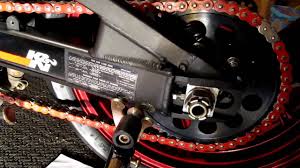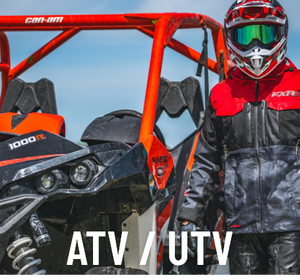Simply select "affirm" at checkout.

How To Adjust & Maintain A Motorcycle Chain
I've been getting a lot of questions lately about chains, sprocket, and chain maintenance.
Our new cars are so reliable, need so little maintenance, and go for such long periods of time before they need any work done, when some people buy bikes, they expect the same performance or long maintenance scheduled from a motorcycle as they do a new car.
Most of the new motorcycles are very, very reliable. You don't have to worry about a lot of things, but there are more things that you have to pay attention to, to keep your bike in good working condition, and to keep up on the maintenance.
And one of those things is chains.
A chain comes in a few different formats. For example, one without o-rings, which are little rubber rings that go between the metal chain plates to help keep grease in, and dirt and water out. On most street bikes, that's what you're going to find is an o-ring chain.
It's important to keep the chain well lubed. A rule of thumb that I've always gone by is with every second tank of fuel, I would give it a little spray or chain wax/lube, wipe it down to get all the old gunk off, and then give it another little spray. I usually do this at the end of my ride when the chain is warm because when it cools it's going to suck all that lubrication into the chain. If you try to grease or put chain wax on a cold chain, a lot of it won't sink in, and a lot of it can fling off.
If you’re watching the video, you’ll see our Motorcycle Technician, Jeremy, with a bike on the stand — he’s putting a new set of plastics on. This is a very typical setup for most sportbike chains. They're very easy to adjust, and it's important to keep your chain adjusted. When it's new, a chain will naturally stretch from just using the power of the bike. So that's the point where you're probably going to want to keep an eye on it the most.
A too-loose chain, if it's loose enough, it can actually get on top of the sprocket and spin. It would have to be incredibly loose to do this but it can happen. Another thing a loose chain will do is you'll have a lot of slop in the throttle. So, you'll go to apply throttle, and that looseness, you'll feel that disconnect from your throttle to the rear wheel as the front sprocket takes up that slack.
On the flip side, if a chain is too tight it will actually bind up your suspension. So, what'll happen, as your wheel tries to travel up through the suspension, the chain will actually inhibit that. All that tension, instead of being on your spring and on your shock, will actually be taken up by the chain. It throws the handling off for the motorcycle completely and puts a lot of unessasary tension on the chain. This can cause the chain to stretch even more and faster.
In our shop, Jeremy sees neglected chains come in on a regular basis. He says that a lot of them come in dirty, loose, and with zero lube on them. Very rarely, he’ll get one that's too tight because people are neglecting them more often than not. They get looser over time and many bike owners that Jeremy talks to don’t even realize their chain is something they can clean. If you don’t take the old grease off the chain, you’re just adding new grease on top of old dirty grease. There’s no way for the new grease to get onto the chain, so you’re just adding to the problem if you don’t clean it.
How To Get The Old Grease Off Your Chain
A Grunge Brush
This is a nice little brush that gets a lot of miles in our shop. It's best to do it around the rear sprocket — it just makes it easier to control without the chain being wobbly down below.
Get your bike up in the air with some sort of a lift, or maybe even a snap jack. We do sell these nice lifts here at the shop — they’re very convenient if you've got a bike with a chain. It's also easier to check the oil like that, adjust the chain, and to clean the bike. It keeps everything nice and stable.
Tirox Chain Cleaner
Your other option for a brush comes in our chain clean canisters, which are fantastic. So, if you don't want to spring the extra dollars for a grunge brush, you can use the Tirox Chain Cleaner. It's kerosene-based product — basically kerosene in a can with some different additives. They package it in a spray can with a neat little brush, which makes it super easy to use.
You open it up and spin it onto your chain. You soak it nicely with the chain clean, rub it back and forth, and it'll really get all that gunk off. It’s a great little kit, and people seem to use it quite a lot.
In the shop, Jeremy gets shocked reviews from every bike owner he uses this with. It takes an old chain that looks like it needs to be replaced and makes it look brand new. Once you wipe off all the gunk, you can apply a good, high-quality chain lube or wax.
We usually wipe off all the gunk and then use soap and dish detergent to really clean up a chain. Then, you dry it — compressed air works best. It gets all the soap, water, and whatever remnants are left in there. Then, it’s a nice coat of chain lube or wax
And just for safety concerns, it’s important to mention here that you always want to have the bike turned off and in neutral when doing any type of work, service, or maintenance.
If the bike was running and you tried to do work on the chain, anything could happen. You could lose a finger or run someone over.
In your manual, it will give you a measurement for chain tension — and a lot of manuals are online now. After you adjust your chain enough, you'll know whether it's too tight or too loose. You’ll get accustomed to the feel, and when it's adjusted properly, you'll know. You can tell because you'll have an instant connection between the throttle and the rear wheel. You won't feel that slop if it's too loose, and your chain won't be as noisy, either — that’s because it's not moving and growing as you're traveling down the road.
You're going to want to loosen your axle. You're going to want to loosen your locknut, and then you use your adjuster bolts to basically move that rear axle in and out. And, obviously, tighten it or loosen it.
So, what can be frustrating though, you will get the chain in the right adjustment and then go to tighten the rear axle nut and the chain will tighten on you. This is because hen you go to tighten your axle, it wants to spin the rear wheel/axle away from the front sproket, and it will tighten the chain up.
Pro Tips & Tricks From Straight The Racetrack
There are a few little cheats, too, that I used to do when I was racing. A lot of times you're changing wheels and you're by yourself, and sometimes you're changing wheels between races in a hurry and it seems you are always in race leathers. haha
So, a trick that I have used to keep the chain in the right tension as you tighten the axle nut, is that you put a wrench in between your chain and the top of your rear sprocket and you just spin it backwards. You don't have to put a ton of tension on it, but you just spin it back to lock that chain at exactly the tension you want. You tighten up your axle bolt, and then when you roll it ahead and remove wrench, you'll still have the exact amount of free play.
Most bikes will have a sticker somewhere on the chain guard or near it that will tell you the recommend measurement for chain tension.
Another thing is that when you're adjusting your chain, remember that you've got your adjuster nut on both side of the axle. Whatever you're doing to one side, you want to do on the other side, because that's going to control the alignment of your rear wheel.
I used to count the threads on the adjuster nut. Some people will measure from the axle to a fixed point on the motorcycle. Another thing I was shown at the racetrack is that if you pull the tension out of the bottom of your chain and look up the rear sprocket, (up your chain — use it like a gun sight) you'll be able to tell if that rear sprocket is offset, even the slightest little bit.
You press down or up on the bottom run of the chain, to take all the tension out of that chain, and then you want to look up the chain from the back of the rear sprocket and see that it’s straight as a pin. If your rear sprocket is misaligned with your front sprocket, your chain is going to be running off to one side and you will be able to see it using this method. If your rear axle is not aligned with the front sprocket the chain and the tire will be running off at an angle and this will wear out a chain and tire very quickly.
If you keep your chain adjusted and lubed, it'll last so much longer. We've seen customers purchase a new chain and sprocket from us, and unfortunately never grease or adjusted it, and literally wear it out in one season of riding. Then they’re upset because a brand new chain shouldn’t be like that. They just didn’t realize it required maintenance to stay in good shape. You’ve got to keep them adjusted and lubed, and realize that there's no point in putting good, new lube on top of old, dirty lube.
















Leave a comment